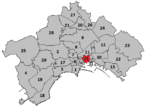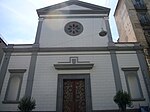San Giovanni a Mare, Naples

San Giovanni a Mare (Italian: [ˈsan dʒoˈvanni a mˈmaːre] St. John at Sea) is a church in Naples, Italy; located near the docks, not far from the church of Sant'Eligio Maggiore. The Romanesque church was erected by Benedictine monks before the 12th century. By the 13th century, the church was attached to a hostel of the knightly order of Gerosolimitani ("Knights Hospitaller"). For some time, the church too belonged to the knights. The hostel was closed by Napoleonic forces, but was returned to the Church in 1828. The church building has been recently restored. Interior columns are spolia. Arabic and Byzantine influences can be seen in some of the apse columns. Other arches in the dome recall architecture of Amalfi.
Excerpt from the Wikipedia article San Giovanni a Mare, Naples (License: CC BY-SA 3.0, Authors, Images).San Giovanni a Mare, Naples
Via San Giovanni a Mare, Naples Pendino
Geographical coordinates (GPS) Address External links Nearby Places Show on map
Geographical coordinates (GPS)
| Latitude | Longitude |
|---|---|
| N 40.846525 ° | E 14.26327 ° |
Address
Chiesa di San Giovanni a Mare
Via San Giovanni a Mare
80138 Naples, Pendino
Campania, Italy
Open on Google Maps










